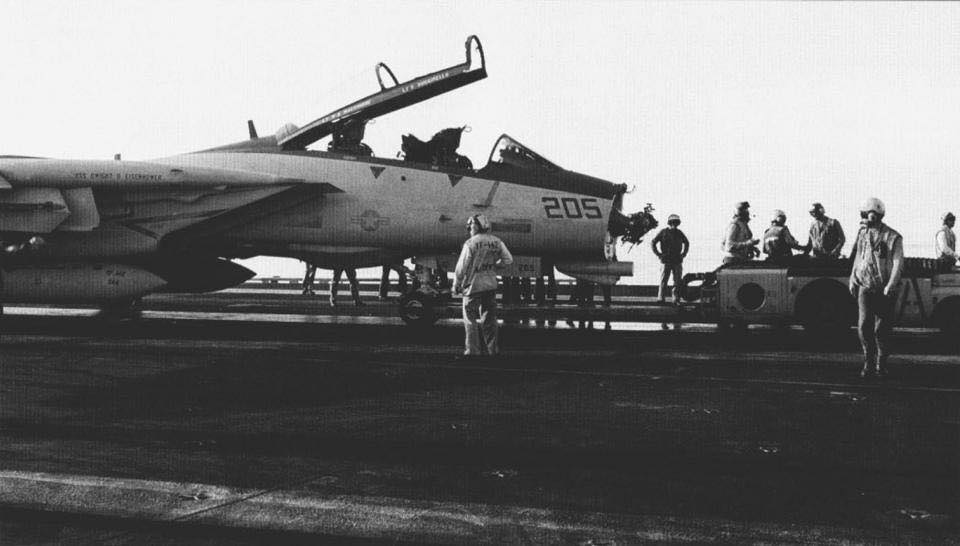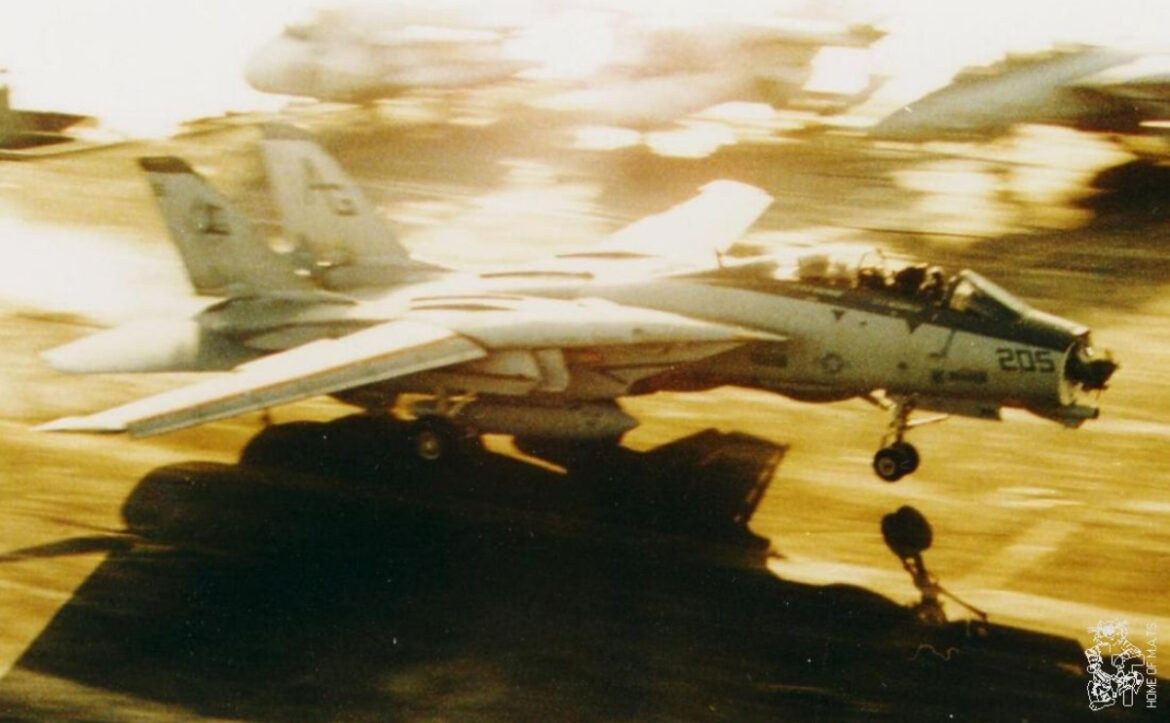‘We started an ACM engagement and as soon as I got a little G on the airplane, that [radar dome] failed…’ Joe Edwards, VF-142 F-14 Tomcat Pilot
Established on August 24, 1948, US Navy Fighter Squadron 193 (VF-193) Ghostriders flew F4U Corsair. Before transitioning into the jet era in 1953 with the F2H Banshee, it made two deployments to Korea with the Corsair. It went from the F3H Demon in 1958 to the F-4 Phantom II in 1963, when it was redesigned as the VF-142. Following eleven years of flying the Phantom, which included multiple combat tours in Vietnam, the squadron switched to the F-14 Tomcat in 1974. The Ghostriders successfully intercepted a Soviet Tu-95 Bear bomber with an F-14 for the first time in 1976. Before being disestablished in 1995, the squadron flew the F-14 for a total of twenty-one years.

The pictures in this post were taken on Nov. 13, 1991, and depict a U.S. Navy Grumman F-14B Tomcat (BuNo 161433) from Fighter Squadron 142 (VF-142) “Ghost Riders” on board the aircraft carrier USS Dwight D. Eisenhower (CVN-69). At 8,200 meters over the Persian Gulf, the crew—led by LtCdr. Joe F. Edwards and Lt. JG Scott C. Grundmeier—had to perform an emergency landing after the nose cone came off due to a latching mechanism failure.
On Full Disc Aviation, Joe Edwards had an insightful interview regarding this episode. This is what Edwards said to the FDA staff at Full Disc Aviation.
FDA: Do you feel comfortable talking about your F-14 convertible landing? The radome broke off, correct?

Joe: Yeah, there was a locking mechanism at the 6 o’clock position underneath the fuselage on the F-14 where you lock the radome down… radome is radar dome… there’s a flat radar antenna back behind there, and the locking mechanism had corroded, and actually fell out into the ocean. We started the day with an ACM engagement about 25–35 miles from the ship with the CO of my squadron – Dick “Weasel” Gallagher. I ran the Operations and Maintenance departments for him during my department head tour in VF-142. Weasel is a great American and a great friend and we always had a fine time wrestling with each other during close-in dogfighting. Most importantly, I was flying that day with Scott “Grundy” Grundemier, a Naval Academy classmate of mine (and also a former squadron mate, as was Weasel, in VF-143 a few years before this). Grundy was one of the finest RIOs the Navy ever had, and his experience, headwork, and decision-making skills were critical to our ability to safely land the airplane on IKE. It’s too lengthy a story to tell here, but after landing on the ship, I found that my eye’s iris had prolapsed and extended out of my eye through a 3 mm cut in the cornea. I was medevac’d to the International Hospital of Bahrain where surgery was performed on my eye. I was released 10 days later. Anyway, we started an ACM engagement and as soon as I got a little G on the airplane, that [radar dome] failed..the hinge for the radome is at the 12 o’clock position and it was put there so that you could raise that thing up and sit it back on top of the airplane on a crowded carrier deck or hangar deck, so when that thing failed it rotated on its hinge and if you ever go to the [Udvar Hazy] Air and Space Museum here at Dulles, and you look at that radome [on the F-14] and you turn it 180 degrees, you see that the angle of attack probe is right in front of the pilot’s face, so that’s what hit me. It crashed through the canopy, that hit me in the face and took out my right eye, broke my collarbone…
FDA: What speed were you flying when that happened?
Joe: Ground speed we were going about 600 knots at 28,000 feet, so it was a loud boom, explosive decompression, and the airplane was damaged, a lot of glass in the cockpit, a lot of glass in my eyes… so at 28,000 feet, I didn’t have any oxygen and I didn’t realize it at the time. When it hit me in the face I’d probably be severely disfigured today had I not been wearing an oxygen mask; the plastic form of the oxygen mask was intact but I lost the hose, so I didn’t have any oxygen, I was breathing ambient air. So I quickly circled down, pulled the throttles to idle, put the boards out, circled down, didn’t have any canopy around me, couldn’t see out of the front of the airplane because the plexiglass was so cracked with pieces missing…the captain of the ship was a guy named Bill Cross and he became an admiral after that tour, and Admiral Cross…when I came by the ship at flight deck level, I couldn’t talk to anyone of course because I didn’t have any communications fittings going up to my microphone that’s still in the hard shell of my mask…so I dropped the gear, dropped the flaps, lowered the tailhook, came up the side of the ship to tell them I needed to land immediately, and Bill Cross immediately started turning the carrier back into the wind to give me a chance to recover the airplane. Of course I couldn’t talk to anyone, and I didn’t even know the nose of the airplane was missing because you can’t see it from the cockpit; it’s a Navy airplane, gotta be able to see the ship when you’re landing. So I did two practice approaches in the 10 minutes it took the aircraft carrier to turn around and steadied up on a base recovery course 322 degrees and I flew an approach and landed on the ship; trapped…that was my last carrier landing; I knew it was going to be because I was blind in my right eye, and I knew I’d never fly again. But, they medevac’d me out after a few hours and the helicopter landed there at night, I had two IV’s swinging, I was laying wrapped in stokes litter when a Navy nurse from San Diego, California, named Gail Little…met me at the helo, and we were on this ambulance riding through the narrow middle eastern streets like we were in the move “Raiders of the Lost Ark”, I actually told Gail to tell the ambulance driver I’m not going to die on the way to the hospital, but I might die if he wrecks the ambulance, he needs to slow down [laughter] so he slowed down, took me right into surgery…they sewed up a 3mm cut with six stitches and four years later I showed up to Johnson Space Center as an astronaut. We used to say sometimes it’s better to be lucky than good.
Special thanks to Full Disc Aviation Staff
Photo by U.S. Navy and U.S. Navy via HOME OF M.A.T.S.

